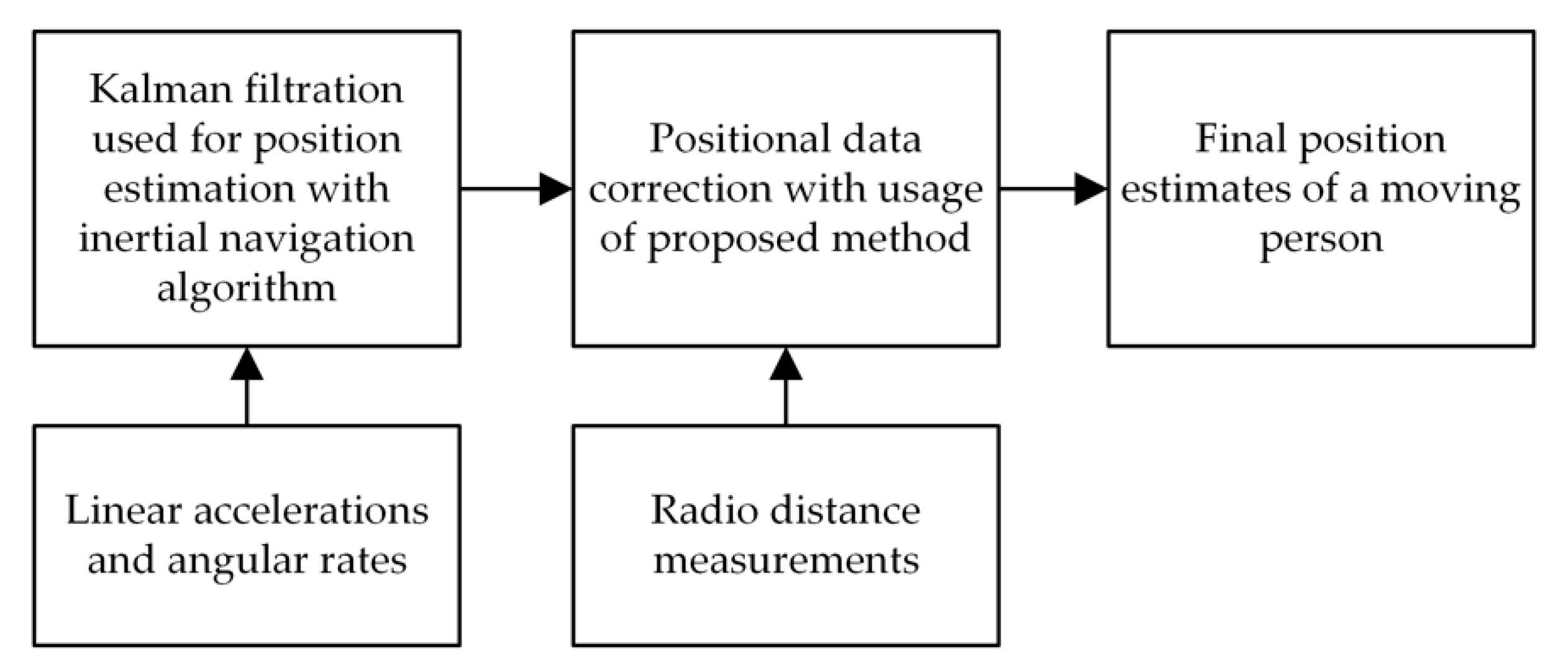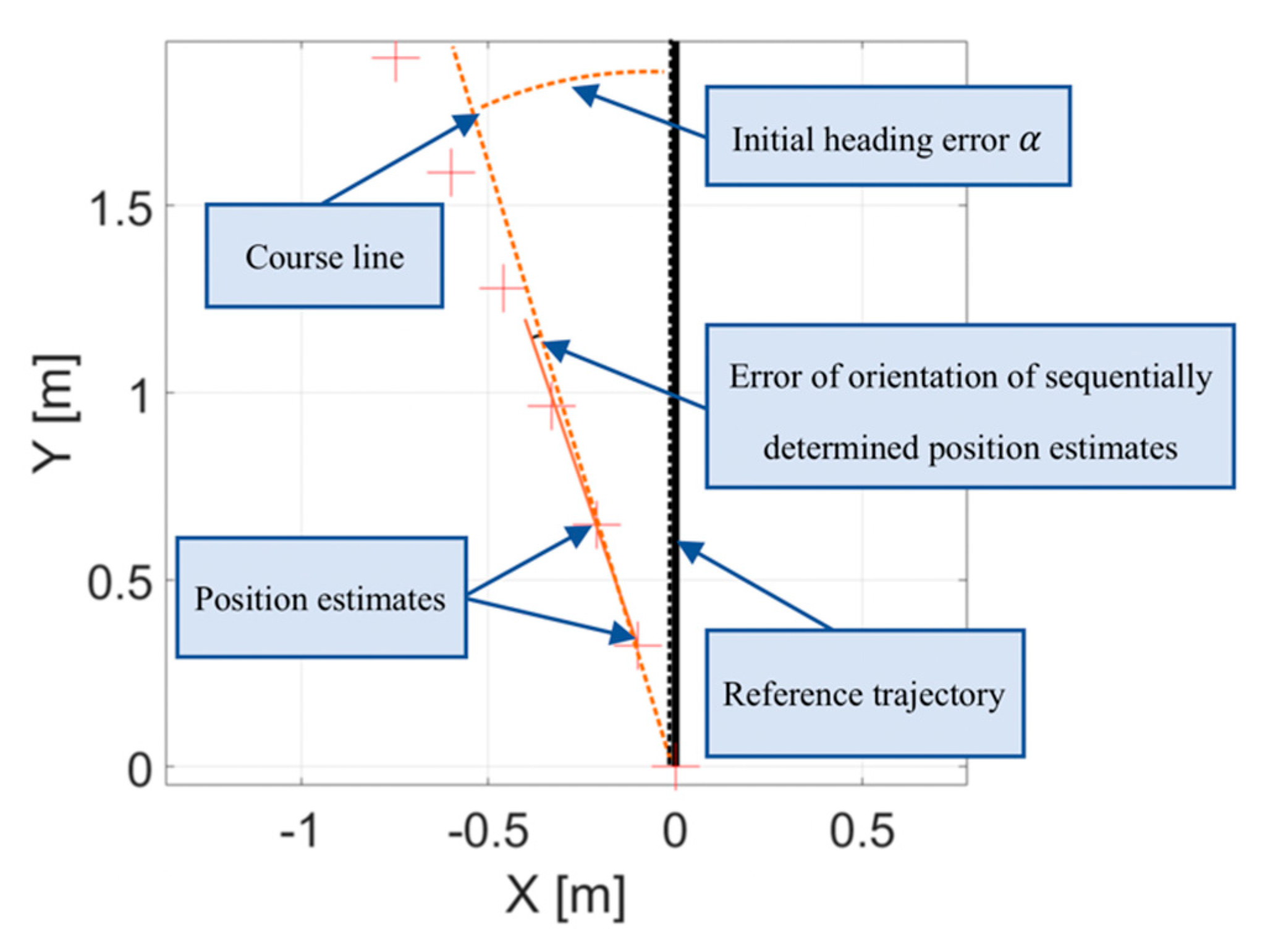Person Tracking in Ultra-Wide Band Hybrid Localization System Using Reduced Number of Reference Nodes
Abstract
1. Introduction
- Dead reckoning based on inertial sensors to measure displacement and orientation change (also named inertial navigation);
- Radiolocalization.
- The measurement method errors of the selected radio signals parameters, i.e., the power level resolution and uncertainty or the time of arrival measurements;
- Errors related to ambiguous or inaccurate relation of a measured radio signal parameter with geometric relations in the localization system, i.e., inaccurate estimation of the received signal power level as a function of the distance between the MN and RN;
- Errors caused by the propagation environment, mainly errors in measured time of arrival of a radio signal due to the multipath propagation effect and blocking of the direct component during transmission through walls or ceilings;
- Errors resulting from geometric dependencies in the localization system, caused by unfavorable deployment of the reference nodes, where even small errors in measured parameters of the received radio signals cause large errors of the estimated position, so-called high value of the DOP (Dilution of Precision) parameter [1,7,8].
Related Works
- -
- Smartmuseum project [11] supporting exhibition tours both in open and indoor areas, using satellite GPS navigation and RFID tags as a source of positional information;
- -
- WiFiSLAM [12]: localization system determining the position of user terminals based on the measurement of the signal levels from the WiFi access points and created indoor signal level maps. This system has been used, e.g., in stores and shopping centers to monitor customer activity and as an extension of the social network portals to find people in the neighborhood. To determine the position of a person the Gaussian Process Latent Variable Model was implemented that allows achieving a reasonable accuracy on the basis of one positional data—the signal strength;
- -
- The system developed by INTERMODALICS [13] is mainly dedicated for indoor person tracking inside urban and public buildings. It is based on a data obtained from a camera that significantly simplifies the system structure and eliminates the need of equipping the tracked person with a mobile node or in general a tag. The positional data are combined with a building’s plan (a map matching process) to increase the system accuracy.
2. The Proposed Method for Positional Data Integration in Hybrid Localization System
2.1. Description of the Proposed Method of Positional Data Integration
2.1.1. Correction of the Initial Heading Error
2.1.2. Correction of the Heading Error of Successively Determined Position Estimates
3. Simulation Studies of Person Tracking in Hybrid Localization System with Reduced Number of Reference Nodes
3.1. Prototype of Hybrid Localization System
3.1.1. The Structure of the Mobile and Reference Nodes
3.2. Model of the Hybrid Localization System
3.3. Simulation Studies of Tracking Efectiveness Using the Proposed Method
4. Experimental Measurement Studies of Person Tracking in a Real Hybrid Localization System
4.1. Measurement Campaign
4.2. Experimental Results
5. Discussion of the Simulation and Measurement Studies
6. Conclusions
7. Patents
Author Contributions
Funding
Acknowledgments
Conflicts of Interest
References
- Werner, M. Indoor Location-Based Services: Prerequisites and Foundations; Springer: Cham, Switzerland, 2014. [Google Scholar]
- Rajchowski, P. Research and Analysis Precision of Position Estimation of Moving Object in Hybrid Localization System (In Polish). Ph.D. Thesis, Gdansk University of Technology, Gdansk, Poland, 2017. [Google Scholar]
- Sadowski, J.; Rajchowski, P.; Cwalina, K.K. Tracking Body Movement for Radio Channel Measurements in BAN with Indoor Positioning System. In Proceedings of the IEEE 2016 URSI Asia-Pacific Radio Science Conference (URSI AP-RASC), Seoul, Korea, 21–25 August 2016; pp. 1380–1382. [Google Scholar]
- Hol, J.D.; Dijkstra, F.; Lunge, H.; Schon, T.B. Tightly Coupled UWB/IMU Pose Estimation; Linkoping University: Linkoping, Sweden, 2009. [Google Scholar]
- De Angelis, A.; Nilsson, J.O.; Skog, I.; Carbone, P. Indoor Positioning by Ultra Wideband Radio Aided Inertial Navigation. In Proceedings of the XIX IMEKO World Congress Fundamental and Applied Metrology, Lisbon, Portugal, 6–11 September 2009. [Google Scholar]
- Gosiewski, Z.; Ortył, R. Strapdown Inertial Navigation System Part 2—Error Models. J. Theor. Appl. Mech. 1998, 36, 937–962. [Google Scholar]
- Olson, F.; Rantakokko, J.; Nygårds, J. Cooperative Localization Using a Foot-Mounted Inertial Navigation System and Ultrawideband Ranging. In Proceedings of the 2014 International Conference on Indoor Positioning and Indoor Navigation, Busan, Korea, 27–30 October 2014. [Google Scholar]
- Kok, M.; Hol, D.K.; Schon, T. Indoor Positioning Using Ultrawideband and Inertial Measurements; Uppsala University: Uppsala, Sweden, 2015. [Google Scholar]
- Schmidhammer, M.; Walter, M.; Gentner, C.; Sand, S. Physical Modeling for Device-Free Localization exploiting Multipath Propagation of Mobile Radio Signals. In Proceedings of the 14th European Conference on Antennas and Propagation (EuCAP), Kopenhagen, Denmark, 15–20 March 2020. [Google Scholar]
- Nilsson, J.; Skog, I. Foot-Mounted INS for Everybody—An Open-Source Embedded Implementation. In Proceedings of the IEEE Position Location and Navigation Symposium (PLANS), Myrtle Beach, SC, USA, 23–26 April 2012. [Google Scholar]
- Smart Museum as a Way to Present Cultural Heritage. Available online: https://www.keep.eu/project/24110/smart-museum-as-a-way-to-present-cultural-heritage (accessed on 20 December 2019).
- Mirowski, P.; Ho, T.K.; Yi, S.; MacDonald, M. Signal SLAM: Simultaneous Localization and Mapping with Mixed WiFi, Bluetooth, LTE and Magnetic Signals. In Proceedings of the International Conference on Indoor Positioning and Indoor Navigation, Montbeliard-Belfort, France, 28–31 October 2013. [Google Scholar]
- Intermodalics—Visual Positioning. Available online: https://www.intermodalics.eu (accessed on 20 December 2019).
- Macoir, N.; Bauwens, J.; Jooris, B.; Van Herbruggen, B.; Rossey, J.; Hoebeke, J.; De Poorter, E. UWB Localization with Battery-Powered Wireless Backbone for Drone-Based Inventory Management. Sensors 2019, 19, 467. [Google Scholar] [CrossRef] [PubMed]
- Hawkinson, W.; Samanant, P.; McCroskey, R.; Ingvalson, R.; Kulkarni, A.; Haas, L.; English, B. GLANSER: Geospatial Location, Accountability, and Navigation System for Emergency Responders. In Proceedings of the 2012 IEEE/ION Position, Location and Navigation Symposium, Myrtle Beach, SC, USA, 23–26 April 2012. [Google Scholar]
- Gezici, S.; Poor, H.V. Position Estimation via Ultra-Wide-Band Signals. Proc. IEEE 2009, 97, 386–403. [Google Scholar] [CrossRef]
- Zhang, J.; Orlik, P.V.; Sahinoglu, Z.; Molisch, A.F.; Kinney, P. UWB Systems for Wireless Sensor Networks. Proc. IEEE 2009, 97, 313–331. [Google Scholar] [CrossRef]
- Laaraiedh, M.; Avrillon, S.; Uguen, B. Hybrid Data Fusion Techniques for Localization in UWB Networks. In Proceedings of the 6th Workshop on Positioning, Navigation and Communication 2009 (WPNC’09), Hannover, Germany, 19 March 2019. [Google Scholar]
- Wei, L.; Jian, Z.; Chunzhi, W.; Hui, X. Kalman Filter Localization Algorithm Based on SDS—TWR Ranging. Telkomnika 2013, 11, 1436–1448. [Google Scholar] [CrossRef]
- Walsh, M.; Tedesco, S.; Ye, T.; O’Flynn, B. A Fully—Coupled Hybrid IEEE 802.15.4a Ultra-Wideband/Inertial Sensor Platform for Wearable Applications; University College Cork: Cork, Ireland, 2014. [Google Scholar]
- Rajchowski, P.; Cwalina, K.K.; Sadowski, J. Research and Analysis of Accuracy of Location Estimation in Inertial Navigation System. Appl. Mech. Mater. 2016, 817, 308–316. [Google Scholar] [CrossRef]
- Sadowski, J. Research and Analysis of Radiolocalization Systems for Special Applications; Gdansk University of Technology: Gdansk, Poland, 2018. (In Polish) [Google Scholar]
- Rajchowski, P.; Cwalina, K.; Sadowski, J.; Stefański, J. Hybrid System for a Person Tracking in Harsh Indoor Environments. In Proceedings of the 2019 European Navigation Conference (ENC), Warsaw, Poland, 9–12 April 2019. [Google Scholar]
- Cwalina, K.; Ambroziak, S.J.; Rajchowski, P.; Sadowski, J.; Stefański, J. A Novel Bitrate Adaptation Method for Heterogeneous Wireless Body Area Networks. Appl. Sci. 2018, 8, 1209. [Google Scholar] [CrossRef]
- Grewal, M.S.; Andrews, A.P. Kalman Filtering, Theory and Practice Using MATLAB, 3rd ed.; Wiley & Sons: Hoboken, NJ, USA, 2008. [Google Scholar]









| RMSEpos Error of Position Estimates from Simulated Inertial Navigation System [m] | No. of Available Reference Nodes | RMSEpos Error of Final Position Estimates [m] | Reduction of the RMSEpos Error [%] |
|---|---|---|---|
| 1.83 | 4 | 0.63 | 65 |
| 3 | 0.81 | 55 | |
| 2 | 0.59 | 67.2 | |
| 1 | 0.72 | 60.2 |
| RMSEpos Error of Position Estimates from Inertial Navigation System [m] | No. of Reference Nodes | RMSEpos Error of Final Position Estimates [m] | Reduction of the RMSEpos Error [%] |
|---|---|---|---|
| 1.04 | 4 | 0.47 | 55 |
| 3 | 0.48 | 54 | |
| 2 | 0.51 | 51 | |
| 1 | 0.54 | 48 |
© 2020 by the authors. Licensee MDPI, Basel, Switzerland. This article is an open access article distributed under the terms and conditions of the Creative Commons Attribution (CC BY) license (http://creativecommons.org/licenses/by/4.0/).
Share and Cite
Rajchowski, P.; Stefanski, J.; Sadowski, J.; Cwalina, K.K. Person Tracking in Ultra-Wide Band Hybrid Localization System Using Reduced Number of Reference Nodes. Sensors 2020, 20, 1984. https://doi.org/10.3390/s20071984
Rajchowski P, Stefanski J, Sadowski J, Cwalina KK. Person Tracking in Ultra-Wide Band Hybrid Localization System Using Reduced Number of Reference Nodes. Sensors. 2020; 20(7):1984. https://doi.org/10.3390/s20071984
Chicago/Turabian StyleRajchowski, Piotr, Jacek Stefanski, Jaroslaw Sadowski, and Krzysztof K. Cwalina. 2020. "Person Tracking in Ultra-Wide Band Hybrid Localization System Using Reduced Number of Reference Nodes" Sensors 20, no. 7: 1984. https://doi.org/10.3390/s20071984
APA StyleRajchowski, P., Stefanski, J., Sadowski, J., & Cwalina, K. K. (2020). Person Tracking in Ultra-Wide Band Hybrid Localization System Using Reduced Number of Reference Nodes. Sensors, 20(7), 1984. https://doi.org/10.3390/s20071984





